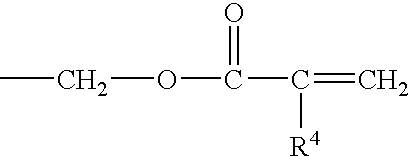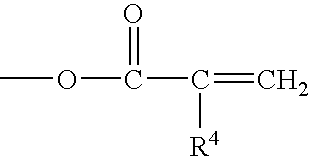Adhesive compositions for bonding passive substrates
a technology of passive substrates and adhesive compositions, which is applied in the direction of adhesive types, synthetic resin layered products, coatings, etc., can solve the problems of magnesium alloys being particularly insensitive to anaerobic cure and poor suitability for industrial applications
- Summary
- Abstract
- Description
- Claims
- Application Information
AI Technical Summary
Problems solved by technology
Method used
Image
Examples
example 1
Comparison of Anaerobic Adhesives with and Without Organic Hydrazine
[0056] Anaerobic adhesive Composition A was prepared from a mixture of 93.00% w / w methacrylate ester monomers (78.00% urethane-methacrylate-acry-late monomers; 15.00% hydroxypropyl methacrylate), 6.00% acrylic acid, and 1.00% CHP. Five compositions were subsequently prepared from Composition A as indicated below:
2TABLE 2 Additive to % Additive Composition Composition A (% w / w) Polymer Adhesion 1 None -- soft + tacky poor 2 Onium Salt 1 1.0 hard + dry poor 3 Onium Salt 3 1.0 hard + dry poor 4 Onium Salt 9 1.0 hard + dry poor 5 1-acetyl-2- 0.95 hard + dry good phenylhydrazine
[0057] Cast magnesium lap-shear joints were assembled with Compositions 1-5. The bondline gap was set at 0.254 mm (10 mil) and the joints were allowed to cure at room temperature for 24 hours. After curing, a qualitative assessment of the degree of polymerization and adhesive strength was made. All but Composition 5 showing poor adhesion.
[0058] Co...
example 2
[0060] To determine which onium salts are most effective at promoting adhesive strength of anaerobic adhesives on magnesium surfaces, anaerobic adhesive Composition B was formulated to which onium salts 1-9 (Table I) were added. Composition B comprised a mixture of triethyleneglycol dimethacrylate (TRIEGMA) 87.5% w / w, hydroxypropyl methacrylate (HPMA) 10.0% w / w, CHP 1.5% w / w, and 1.0% w / w of the onium salt being tested. Additionally, one mixture was formulated as a control in which no onium salt was present.
[0061] One gram of each of the ten compositions was placed in each of two glass vials. To one vial was added 0.01 grams of magnesium shavings, which were used as a model for the alloy substrates. The vials were left at room temperature for 24 hours and then examined for gellation. The results are presented in Table 3.
3TABLE 3 Results of the room temperature gel-test experiments in model anaerobic adhesives with and without magnesium turnings Salt # Present In 24 hour gel 24 hour ...
example 3
[0065] Composition 5 (mixture of urethane-acrylate monomers, hydroxypropyl methacrylate, acrylic acid, CHP, and 1-acetyl-2-phenylhydrazine) was used as a base formulation for measuring the effect of allyltriphenylphosphoni-um bromide (ATPB) (Salt 3 in Table I) as a curing activator on magnesium alloy substrates. Adhesive formulations containing 0.25, 0.5, 1.0, and 2.0% w / w ATPB dissolved in Composition 5 were prepared in low density polyethylene bottles by adding approximately half the required amount of Composition 5 to the bottle followed by the phosphonium salt and the remainder of Composition 5.
[0066] The mixture was stirred mechanically for about thirty minutes and allowed to sit overnight at room temperature to ensure complete removal of air bubbles. Stability was performed at 82.degree. C. in 10.times.75 mm glass vials in a temperature controlled heating block fitted with a calibrated thermocouple. The magnesium alloy lap-shear specimens were wiped with acetone and allowed to...
PUM
| Property | Measurement | Unit |
|---|---|---|
| degree of polymerization | aaaaa | aaaaa |
| temperature | aaaaa | aaaaa |
| temperature | aaaaa | aaaaa |
Abstract
Description
Claims
Application Information
 Login to View More
Login to View More - R&D
- Intellectual Property
- Life Sciences
- Materials
- Tech Scout
- Unparalleled Data Quality
- Higher Quality Content
- 60% Fewer Hallucinations
Browse by: Latest US Patents, China's latest patents, Technical Efficacy Thesaurus, Application Domain, Technology Topic, Popular Technical Reports.
© 2025 PatSnap. All rights reserved.Legal|Privacy policy|Modern Slavery Act Transparency Statement|Sitemap|About US| Contact US: help@patsnap.com



